Chronic Illness Management in Primary Care
VerifiedAdded on 2023/06/03
|12
|4758
|417
AI Summary
Chronic diseases are the foremost causes of illness, disability and deadly burden in Australia. The chronic ailments accounted for 90% of the deaths in 2011. The chronic diseases have become common along with the changing lifestyles and aging population. The chronic diseases comprise different illness and health conditions. These conditions often coexist and share common risk factors.
Contribute Materials
Your contribution can guide someone’s learning journey. Share your
documents today.

RUNNING HEAD: Chronic illness management in primary care
0
Chronic illness management in primary care
0
Chronic illness management in primary care
Secure Best Marks with AI Grader
Need help grading? Try our AI Grader for instant feedback on your assignments.
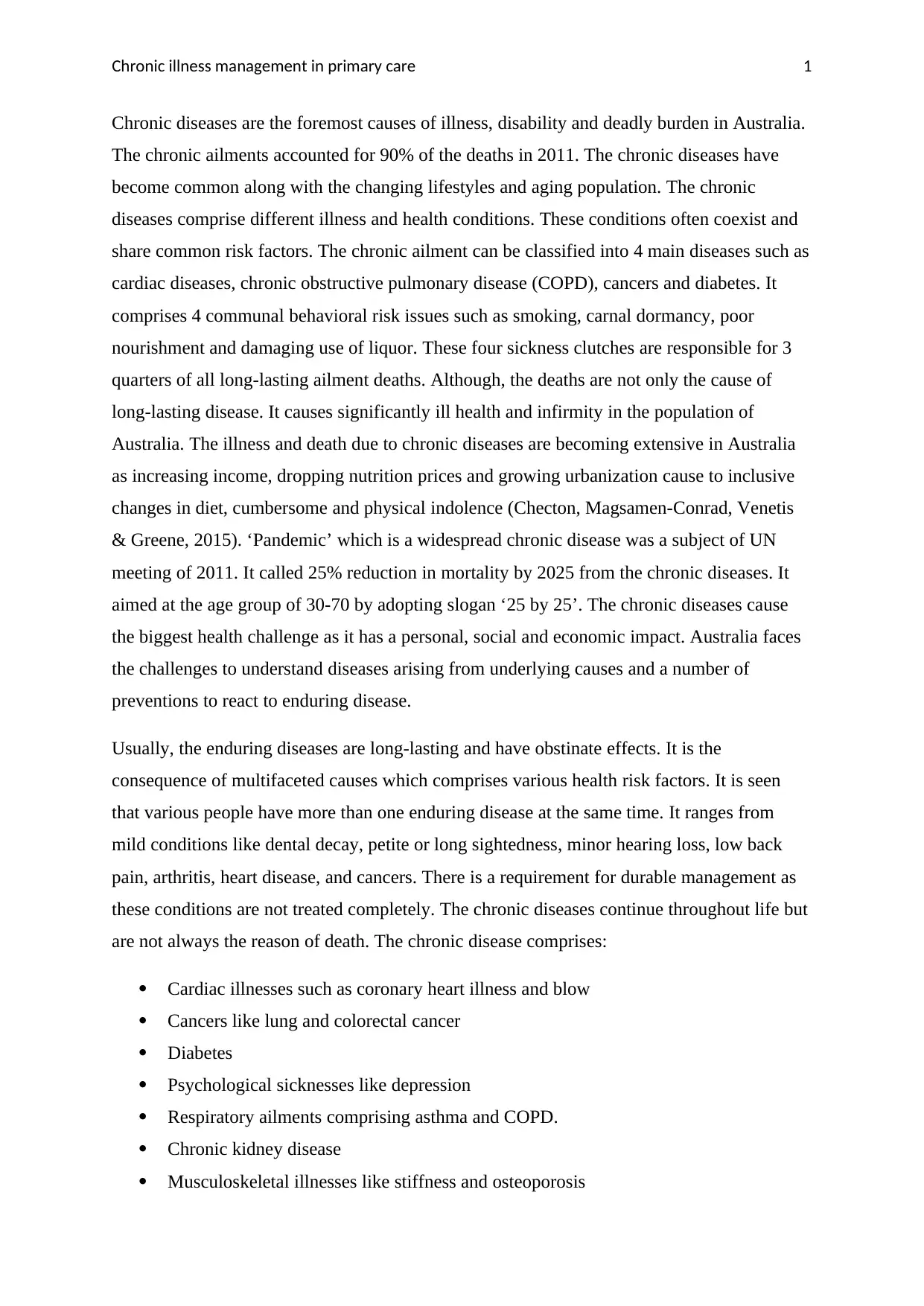
Chronic illness management in primary care 1
Chronic diseases are the foremost causes of illness, disability and deadly burden in Australia.
The chronic ailments accounted for 90% of the deaths in 2011. The chronic diseases have
become common along with the changing lifestyles and aging population. The chronic
diseases comprise different illness and health conditions. These conditions often coexist and
share common risk factors. The chronic ailment can be classified into 4 main diseases such as
cardiac diseases, chronic obstructive pulmonary disease (COPD), cancers and diabetes. It
comprises 4 communal behavioral risk issues such as smoking, carnal dormancy, poor
nourishment and damaging use of liquor. These four sickness clutches are responsible for 3
quarters of all long-lasting ailment deaths. Although, the deaths are not only the cause of
long-lasting disease. It causes significantly ill health and infirmity in the population of
Australia. The illness and death due to chronic diseases are becoming extensive in Australia
as increasing income, dropping nutrition prices and growing urbanization cause to inclusive
changes in diet, cumbersome and physical indolence (Checton, Magsamen-Conrad, Venetis
& Greene, 2015). ‘Pandemic’ which is a widespread chronic disease was a subject of UN
meeting of 2011. It called 25% reduction in mortality by 2025 from the chronic diseases. It
aimed at the age group of 30-70 by adopting slogan ‘25 by 25’. The chronic diseases cause
the biggest health challenge as it has a personal, social and economic impact. Australia faces
the challenges to understand diseases arising from underlying causes and a number of
preventions to react to enduring disease.
Usually, the enduring diseases are long-lasting and have obstinate effects. It is the
consequence of multifaceted causes which comprises various health risk factors. It is seen
that various people have more than one enduring disease at the same time. It ranges from
mild conditions like dental decay, petite or long sightedness, minor hearing loss, low back
pain, arthritis, heart disease, and cancers. There is a requirement for durable management as
these conditions are not treated completely. The chronic diseases continue throughout life but
are not always the reason of death. The chronic disease comprises:
Cardiac illnesses such as coronary heart illness and blow
Cancers like lung and colorectal cancer
Diabetes
Psychological sicknesses like depression
Respiratory ailments comprising asthma and COPD.
Chronic kidney disease
Musculoskeletal illnesses like stiffness and osteoporosis
Chronic diseases are the foremost causes of illness, disability and deadly burden in Australia.
The chronic ailments accounted for 90% of the deaths in 2011. The chronic diseases have
become common along with the changing lifestyles and aging population. The chronic
diseases comprise different illness and health conditions. These conditions often coexist and
share common risk factors. The chronic ailment can be classified into 4 main diseases such as
cardiac diseases, chronic obstructive pulmonary disease (COPD), cancers and diabetes. It
comprises 4 communal behavioral risk issues such as smoking, carnal dormancy, poor
nourishment and damaging use of liquor. These four sickness clutches are responsible for 3
quarters of all long-lasting ailment deaths. Although, the deaths are not only the cause of
long-lasting disease. It causes significantly ill health and infirmity in the population of
Australia. The illness and death due to chronic diseases are becoming extensive in Australia
as increasing income, dropping nutrition prices and growing urbanization cause to inclusive
changes in diet, cumbersome and physical indolence (Checton, Magsamen-Conrad, Venetis
& Greene, 2015). ‘Pandemic’ which is a widespread chronic disease was a subject of UN
meeting of 2011. It called 25% reduction in mortality by 2025 from the chronic diseases. It
aimed at the age group of 30-70 by adopting slogan ‘25 by 25’. The chronic diseases cause
the biggest health challenge as it has a personal, social and economic impact. Australia faces
the challenges to understand diseases arising from underlying causes and a number of
preventions to react to enduring disease.
Usually, the enduring diseases are long-lasting and have obstinate effects. It is the
consequence of multifaceted causes which comprises various health risk factors. It is seen
that various people have more than one enduring disease at the same time. It ranges from
mild conditions like dental decay, petite or long sightedness, minor hearing loss, low back
pain, arthritis, heart disease, and cancers. There is a requirement for durable management as
these conditions are not treated completely. The chronic diseases continue throughout life but
are not always the reason of death. The chronic disease comprises:
Cardiac illnesses such as coronary heart illness and blow
Cancers like lung and colorectal cancer
Diabetes
Psychological sicknesses like depression
Respiratory ailments comprising asthma and COPD.
Chronic kidney disease
Musculoskeletal illnesses like stiffness and osteoporosis
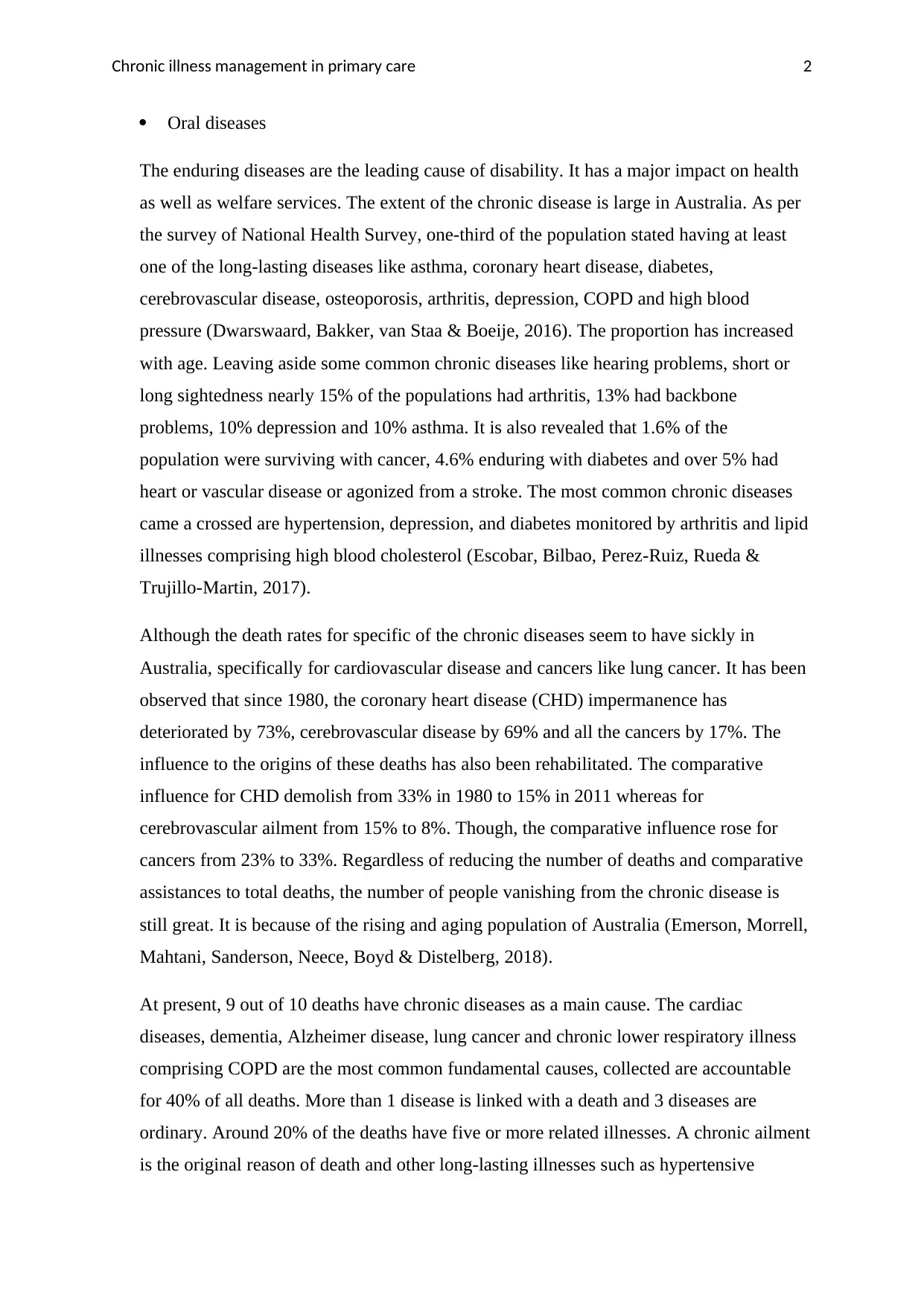
Chronic illness management in primary care 2
Oral diseases
The enduring diseases are the leading cause of disability. It has a major impact on health
as well as welfare services. The extent of the chronic disease is large in Australia. As per
the survey of National Health Survey, one-third of the population stated having at least
one of the long-lasting diseases like asthma, coronary heart disease, diabetes,
cerebrovascular disease, osteoporosis, arthritis, depression, COPD and high blood
pressure (Dwarswaard, Bakker, van Staa & Boeije, 2016). The proportion has increased
with age. Leaving aside some common chronic diseases like hearing problems, short or
long sightedness nearly 15% of the populations had arthritis, 13% had backbone
problems, 10% depression and 10% asthma. It is also revealed that 1.6% of the
population were surviving with cancer, 4.6% enduring with diabetes and over 5% had
heart or vascular disease or agonized from a stroke. The most common chronic diseases
came a crossed are hypertension, depression, and diabetes monitored by arthritis and lipid
illnesses comprising high blood cholesterol (Escobar, Bilbao, Perez-Ruiz, Rueda &
Trujillo-Martin, 2017).
Although the death rates for specific of the chronic diseases seem to have sickly in
Australia, specifically for cardiovascular disease and cancers like lung cancer. It has been
observed that since 1980, the coronary heart disease (CHD) impermanence has
deteriorated by 73%, cerebrovascular disease by 69% and all the cancers by 17%. The
influence to the origins of these deaths has also been rehabilitated. The comparative
influence for CHD demolish from 33% in 1980 to 15% in 2011 whereas for
cerebrovascular ailment from 15% to 8%. Though, the comparative influence rose for
cancers from 23% to 33%. Regardless of reducing the number of deaths and comparative
assistances to total deaths, the number of people vanishing from the chronic disease is
still great. It is because of the rising and aging population of Australia (Emerson, Morrell,
Mahtani, Sanderson, Neece, Boyd & Distelberg, 2018).
At present, 9 out of 10 deaths have chronic diseases as a main cause. The cardiac
diseases, dementia, Alzheimer disease, lung cancer and chronic lower respiratory illness
comprising COPD are the most common fundamental causes, collected are accountable
for 40% of all deaths. More than 1 disease is linked with a death and 3 diseases are
ordinary. Around 20% of the deaths have five or more related illnesses. A chronic ailment
is the original reason of death and other long-lasting illnesses such as hypertensive
Oral diseases
The enduring diseases are the leading cause of disability. It has a major impact on health
as well as welfare services. The extent of the chronic disease is large in Australia. As per
the survey of National Health Survey, one-third of the population stated having at least
one of the long-lasting diseases like asthma, coronary heart disease, diabetes,
cerebrovascular disease, osteoporosis, arthritis, depression, COPD and high blood
pressure (Dwarswaard, Bakker, van Staa & Boeije, 2016). The proportion has increased
with age. Leaving aside some common chronic diseases like hearing problems, short or
long sightedness nearly 15% of the populations had arthritis, 13% had backbone
problems, 10% depression and 10% asthma. It is also revealed that 1.6% of the
population were surviving with cancer, 4.6% enduring with diabetes and over 5% had
heart or vascular disease or agonized from a stroke. The most common chronic diseases
came a crossed are hypertension, depression, and diabetes monitored by arthritis and lipid
illnesses comprising high blood cholesterol (Escobar, Bilbao, Perez-Ruiz, Rueda &
Trujillo-Martin, 2017).
Although the death rates for specific of the chronic diseases seem to have sickly in
Australia, specifically for cardiovascular disease and cancers like lung cancer. It has been
observed that since 1980, the coronary heart disease (CHD) impermanence has
deteriorated by 73%, cerebrovascular disease by 69% and all the cancers by 17%. The
influence to the origins of these deaths has also been rehabilitated. The comparative
influence for CHD demolish from 33% in 1980 to 15% in 2011 whereas for
cerebrovascular ailment from 15% to 8%. Though, the comparative influence rose for
cancers from 23% to 33%. Regardless of reducing the number of deaths and comparative
assistances to total deaths, the number of people vanishing from the chronic disease is
still great. It is because of the rising and aging population of Australia (Emerson, Morrell,
Mahtani, Sanderson, Neece, Boyd & Distelberg, 2018).
At present, 9 out of 10 deaths have chronic diseases as a main cause. The cardiac
diseases, dementia, Alzheimer disease, lung cancer and chronic lower respiratory illness
comprising COPD are the most common fundamental causes, collected are accountable
for 40% of all deaths. More than 1 disease is linked with a death and 3 diseases are
ordinary. Around 20% of the deaths have five or more related illnesses. A chronic ailment
is the original reason of death and other long-lasting illnesses such as hypertensive
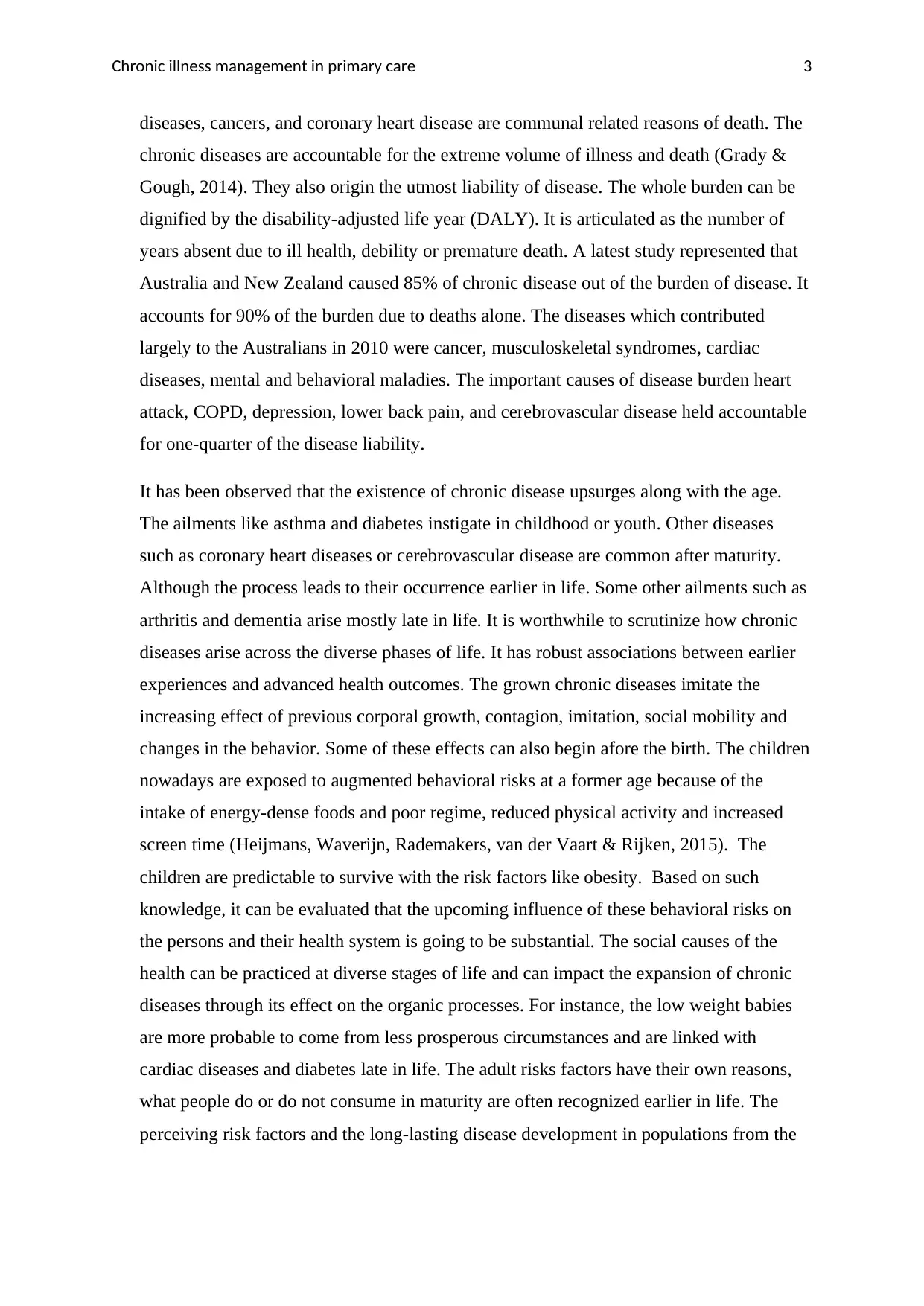
Chronic illness management in primary care 3
diseases, cancers, and coronary heart disease are communal related reasons of death. The
chronic diseases are accountable for the extreme volume of illness and death (Grady &
Gough, 2014). They also origin the utmost liability of disease. The whole burden can be
dignified by the disability-adjusted life year (DALY). It is articulated as the number of
years absent due to ill health, debility or premature death. A latest study represented that
Australia and New Zealand caused 85% of chronic disease out of the burden of disease. It
accounts for 90% of the burden due to deaths alone. The diseases which contributed
largely to the Australians in 2010 were cancer, musculoskeletal syndromes, cardiac
diseases, mental and behavioral maladies. The important causes of disease burden heart
attack, COPD, depression, lower back pain, and cerebrovascular disease held accountable
for one-quarter of the disease liability.
It has been observed that the existence of chronic disease upsurges along with the age.
The ailments like asthma and diabetes instigate in childhood or youth. Other diseases
such as coronary heart diseases or cerebrovascular disease are common after maturity.
Although the process leads to their occurrence earlier in life. Some other ailments such as
arthritis and dementia arise mostly late in life. It is worthwhile to scrutinize how chronic
diseases arise across the diverse phases of life. It has robust associations between earlier
experiences and advanced health outcomes. The grown chronic diseases imitate the
increasing effect of previous corporal growth, contagion, imitation, social mobility and
changes in the behavior. Some of these effects can also begin afore the birth. The children
nowadays are exposed to augmented behavioral risks at a former age because of the
intake of energy-dense foods and poor regime, reduced physical activity and increased
screen time (Heijmans, Waverijn, Rademakers, van der Vaart & Rijken, 2015). The
children are predictable to survive with the risk factors like obesity. Based on such
knowledge, it can be evaluated that the upcoming influence of these behavioral risks on
the persons and their health system is going to be substantial. The social causes of the
health can be practiced at diverse stages of life and can impact the expansion of chronic
diseases through its effect on the organic processes. For instance, the low weight babies
are more probable to come from less prosperous circumstances and are linked with
cardiac diseases and diabetes late in life. The adult risks factors have their own reasons,
what people do or do not consume in maturity are often recognized earlier in life. The
perceiving risk factors and the long-lasting disease development in populations from the
diseases, cancers, and coronary heart disease are communal related reasons of death. The
chronic diseases are accountable for the extreme volume of illness and death (Grady &
Gough, 2014). They also origin the utmost liability of disease. The whole burden can be
dignified by the disability-adjusted life year (DALY). It is articulated as the number of
years absent due to ill health, debility or premature death. A latest study represented that
Australia and New Zealand caused 85% of chronic disease out of the burden of disease. It
accounts for 90% of the burden due to deaths alone. The diseases which contributed
largely to the Australians in 2010 were cancer, musculoskeletal syndromes, cardiac
diseases, mental and behavioral maladies. The important causes of disease burden heart
attack, COPD, depression, lower back pain, and cerebrovascular disease held accountable
for one-quarter of the disease liability.
It has been observed that the existence of chronic disease upsurges along with the age.
The ailments like asthma and diabetes instigate in childhood or youth. Other diseases
such as coronary heart diseases or cerebrovascular disease are common after maturity.
Although the process leads to their occurrence earlier in life. Some other ailments such as
arthritis and dementia arise mostly late in life. It is worthwhile to scrutinize how chronic
diseases arise across the diverse phases of life. It has robust associations between earlier
experiences and advanced health outcomes. The grown chronic diseases imitate the
increasing effect of previous corporal growth, contagion, imitation, social mobility and
changes in the behavior. Some of these effects can also begin afore the birth. The children
nowadays are exposed to augmented behavioral risks at a former age because of the
intake of energy-dense foods and poor regime, reduced physical activity and increased
screen time (Heijmans, Waverijn, Rademakers, van der Vaart & Rijken, 2015). The
children are predictable to survive with the risk factors like obesity. Based on such
knowledge, it can be evaluated that the upcoming influence of these behavioral risks on
the persons and their health system is going to be substantial. The social causes of the
health can be practiced at diverse stages of life and can impact the expansion of chronic
diseases through its effect on the organic processes. For instance, the low weight babies
are more probable to come from less prosperous circumstances and are linked with
cardiac diseases and diabetes late in life. The adult risks factors have their own reasons,
what people do or do not consume in maturity are often recognized earlier in life. The
perceiving risk factors and the long-lasting disease development in populations from the
Secure Best Marks with AI Grader
Need help grading? Try our AI Grader for instant feedback on your assignments.
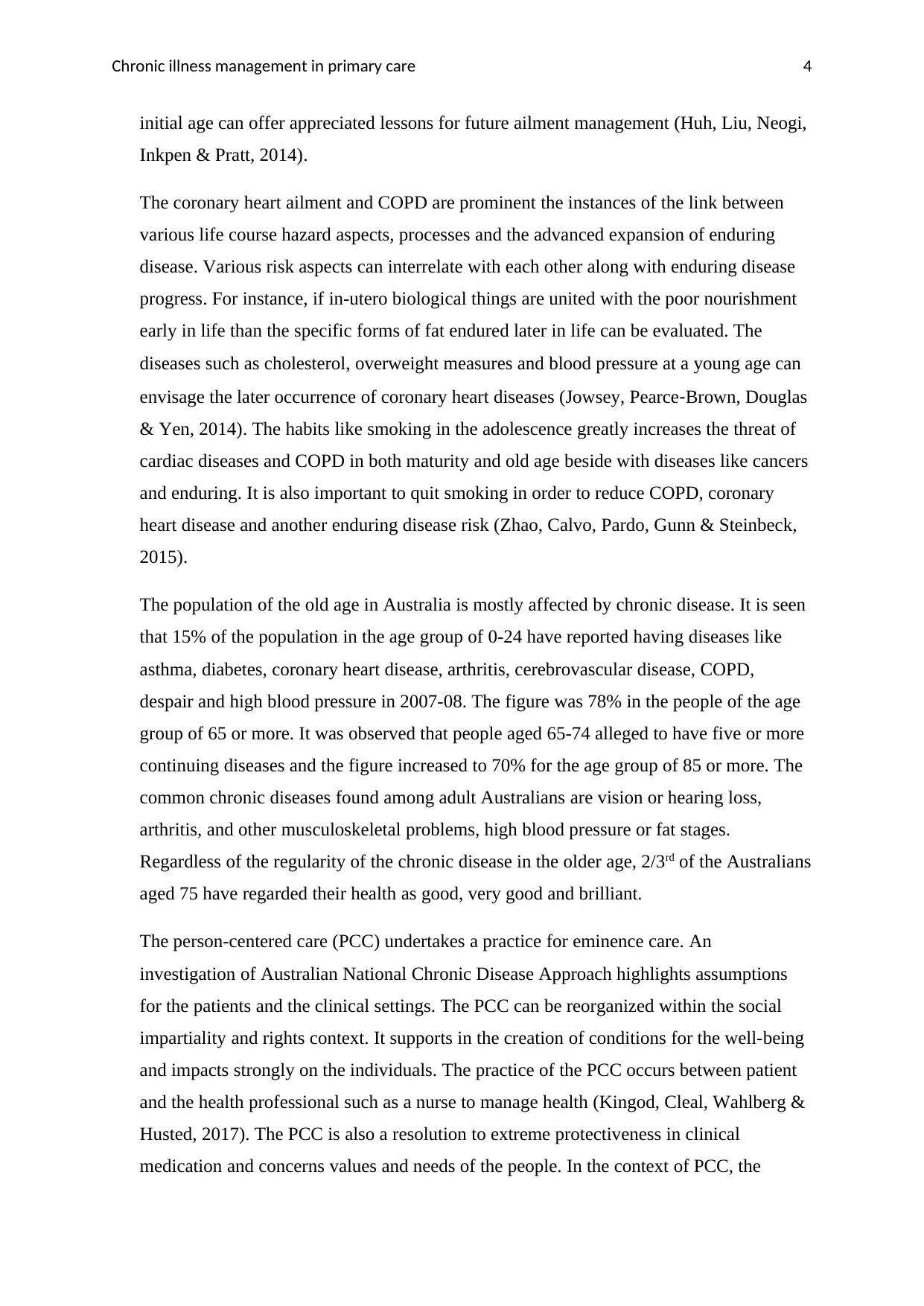
Chronic illness management in primary care 4
initial age can offer appreciated lessons for future ailment management (Huh, Liu, Neogi,
Inkpen & Pratt, 2014).
The coronary heart ailment and COPD are prominent the instances of the link between
various life course hazard aspects, processes and the advanced expansion of enduring
disease. Various risk aspects can interrelate with each other along with enduring disease
progress. For instance, if in-utero biological things are united with the poor nourishment
early in life than the specific forms of fat endured later in life can be evaluated. The
diseases such as cholesterol, overweight measures and blood pressure at a young age can
envisage the later occurrence of coronary heart diseases (Jowsey, Pearce‐Brown, Douglas
& Yen, 2014). The habits like smoking in the adolescence greatly increases the threat of
cardiac diseases and COPD in both maturity and old age beside with diseases like cancers
and enduring. It is also important to quit smoking in order to reduce COPD, coronary
heart disease and another enduring disease risk (Zhao, Calvo, Pardo, Gunn & Steinbeck,
2015).
The population of the old age in Australia is mostly affected by chronic disease. It is seen
that 15% of the population in the age group of 0-24 have reported having diseases like
asthma, diabetes, coronary heart disease, arthritis, cerebrovascular disease, COPD,
despair and high blood pressure in 2007-08. The figure was 78% in the people of the age
group of 65 or more. It was observed that people aged 65-74 alleged to have five or more
continuing diseases and the figure increased to 70% for the age group of 85 or more. The
common chronic diseases found among adult Australians are vision or hearing loss,
arthritis, and other musculoskeletal problems, high blood pressure or fat stages.
Regardless of the regularity of the chronic disease in the older age, 2/3rd of the Australians
aged 75 have regarded their health as good, very good and brilliant.
The person-centered care (PCC) undertakes a practice for eminence care. An
investigation of Australian National Chronic Disease Approach highlights assumptions
for the patients and the clinical settings. The PCC can be reorganized within the social
impartiality and rights context. It supports in the creation of conditions for the well-being
and impacts strongly on the individuals. The practice of the PCC occurs between patient
and the health professional such as a nurse to manage health (Kingod, Cleal, Wahlberg &
Husted, 2017). The PCC is also a resolution to extreme protectiveness in clinical
medication and concerns values and needs of the people. In the context of PCC, the
initial age can offer appreciated lessons for future ailment management (Huh, Liu, Neogi,
Inkpen & Pratt, 2014).
The coronary heart ailment and COPD are prominent the instances of the link between
various life course hazard aspects, processes and the advanced expansion of enduring
disease. Various risk aspects can interrelate with each other along with enduring disease
progress. For instance, if in-utero biological things are united with the poor nourishment
early in life than the specific forms of fat endured later in life can be evaluated. The
diseases such as cholesterol, overweight measures and blood pressure at a young age can
envisage the later occurrence of coronary heart diseases (Jowsey, Pearce‐Brown, Douglas
& Yen, 2014). The habits like smoking in the adolescence greatly increases the threat of
cardiac diseases and COPD in both maturity and old age beside with diseases like cancers
and enduring. It is also important to quit smoking in order to reduce COPD, coronary
heart disease and another enduring disease risk (Zhao, Calvo, Pardo, Gunn & Steinbeck,
2015).
The population of the old age in Australia is mostly affected by chronic disease. It is seen
that 15% of the population in the age group of 0-24 have reported having diseases like
asthma, diabetes, coronary heart disease, arthritis, cerebrovascular disease, COPD,
despair and high blood pressure in 2007-08. The figure was 78% in the people of the age
group of 65 or more. It was observed that people aged 65-74 alleged to have five or more
continuing diseases and the figure increased to 70% for the age group of 85 or more. The
common chronic diseases found among adult Australians are vision or hearing loss,
arthritis, and other musculoskeletal problems, high blood pressure or fat stages.
Regardless of the regularity of the chronic disease in the older age, 2/3rd of the Australians
aged 75 have regarded their health as good, very good and brilliant.
The person-centered care (PCC) undertakes a practice for eminence care. An
investigation of Australian National Chronic Disease Approach highlights assumptions
for the patients and the clinical settings. The PCC can be reorganized within the social
impartiality and rights context. It supports in the creation of conditions for the well-being
and impacts strongly on the individuals. The practice of the PCC occurs between patient
and the health professional such as a nurse to manage health (Kingod, Cleal, Wahlberg &
Husted, 2017). The PCC is also a resolution to extreme protectiveness in clinical
medication and concerns values and needs of the people. In the context of PCC, the
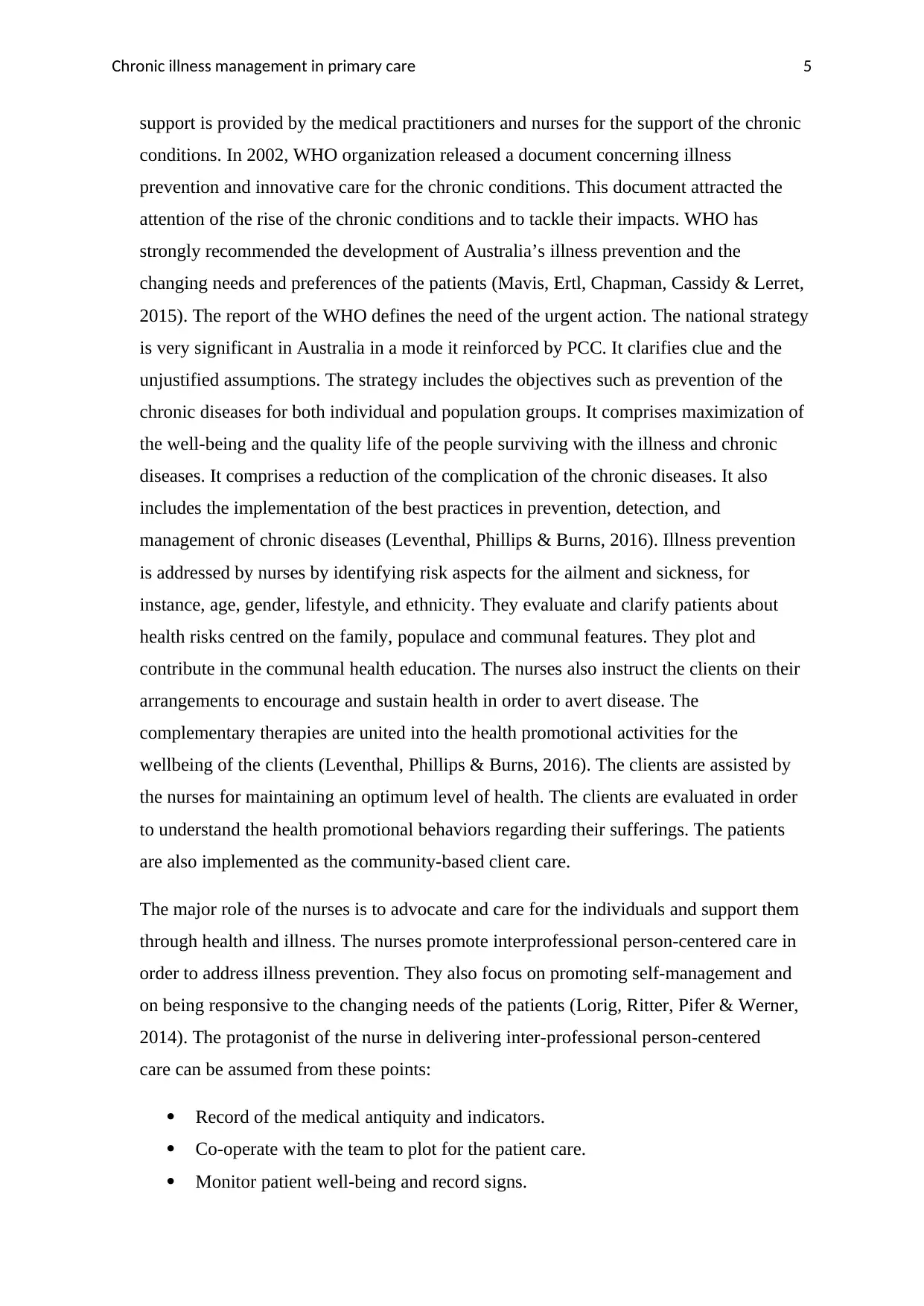
Chronic illness management in primary care 5
support is provided by the medical practitioners and nurses for the support of the chronic
conditions. In 2002, WHO organization released a document concerning illness
prevention and innovative care for the chronic conditions. This document attracted the
attention of the rise of the chronic conditions and to tackle their impacts. WHO has
strongly recommended the development of Australia’s illness prevention and the
changing needs and preferences of the patients (Mavis, Ertl, Chapman, Cassidy & Lerret,
2015). The report of the WHO defines the need of the urgent action. The national strategy
is very significant in Australia in a mode it reinforced by PCC. It clarifies clue and the
unjustified assumptions. The strategy includes the objectives such as prevention of the
chronic diseases for both individual and population groups. It comprises maximization of
the well-being and the quality life of the people surviving with the illness and chronic
diseases. It comprises a reduction of the complication of the chronic diseases. It also
includes the implementation of the best practices in prevention, detection, and
management of chronic diseases (Leventhal, Phillips & Burns, 2016). Illness prevention
is addressed by nurses by identifying risk aspects for the ailment and sickness, for
instance, age, gender, lifestyle, and ethnicity. They evaluate and clarify patients about
health risks centred on the family, populace and communal features. They plot and
contribute in the communal health education. The nurses also instruct the clients on their
arrangements to encourage and sustain health in order to avert disease. The
complementary therapies are united into the health promotional activities for the
wellbeing of the clients (Leventhal, Phillips & Burns, 2016). The clients are assisted by
the nurses for maintaining an optimum level of health. The clients are evaluated in order
to understand the health promotional behaviors regarding their sufferings. The patients
are also implemented as the community-based client care.
The major role of the nurses is to advocate and care for the individuals and support them
through health and illness. The nurses promote interprofessional person-centered care in
order to address illness prevention. They also focus on promoting self-management and
on being responsive to the changing needs of the patients (Lorig, Ritter, Pifer & Werner,
2014). The protagonist of the nurse in delivering inter-professional person-centered
care can be assumed from these points:
Record of the medical antiquity and indicators.
Co-operate with the team to plot for the patient care.
Monitor patient well-being and record signs.
support is provided by the medical practitioners and nurses for the support of the chronic
conditions. In 2002, WHO organization released a document concerning illness
prevention and innovative care for the chronic conditions. This document attracted the
attention of the rise of the chronic conditions and to tackle their impacts. WHO has
strongly recommended the development of Australia’s illness prevention and the
changing needs and preferences of the patients (Mavis, Ertl, Chapman, Cassidy & Lerret,
2015). The report of the WHO defines the need of the urgent action. The national strategy
is very significant in Australia in a mode it reinforced by PCC. It clarifies clue and the
unjustified assumptions. The strategy includes the objectives such as prevention of the
chronic diseases for both individual and population groups. It comprises maximization of
the well-being and the quality life of the people surviving with the illness and chronic
diseases. It comprises a reduction of the complication of the chronic diseases. It also
includes the implementation of the best practices in prevention, detection, and
management of chronic diseases (Leventhal, Phillips & Burns, 2016). Illness prevention
is addressed by nurses by identifying risk aspects for the ailment and sickness, for
instance, age, gender, lifestyle, and ethnicity. They evaluate and clarify patients about
health risks centred on the family, populace and communal features. They plot and
contribute in the communal health education. The nurses also instruct the clients on their
arrangements to encourage and sustain health in order to avert disease. The
complementary therapies are united into the health promotional activities for the
wellbeing of the clients (Leventhal, Phillips & Burns, 2016). The clients are assisted by
the nurses for maintaining an optimum level of health. The clients are evaluated in order
to understand the health promotional behaviors regarding their sufferings. The patients
are also implemented as the community-based client care.
The major role of the nurses is to advocate and care for the individuals and support them
through health and illness. The nurses promote interprofessional person-centered care in
order to address illness prevention. They also focus on promoting self-management and
on being responsive to the changing needs of the patients (Lorig, Ritter, Pifer & Werner,
2014). The protagonist of the nurse in delivering inter-professional person-centered
care can be assumed from these points:
Record of the medical antiquity and indicators.
Co-operate with the team to plot for the patient care.
Monitor patient well-being and record signs.

Chronic illness management in primary care 6
The promoter for health and well-being of the patients.
Conduct diagnostic tests.
Operate medical equipment.
Administer prescriptions and treatments.
Update patients about the management of the illness.
Be responsible for support and advice to the patients.
The WHO defines the health as the wellbeing of the physical, mental and social along with
the absence of the disease. It is the process of the people to increase their control and improve
health. The nurses play important role in the practices such as health promotion and
preventive care. The nurses collaborate and do partnering with the communities and
populations to address the complications to the health. The nurse is a caregiver for the
patients and assists to accomplish physical needs, avert disease and delight rare health
circumstances (Lois & Miller, 2018). They need to observe and monitor the patients in order
to treat them. They record all the relevant information to aid in treatment. The nurses follow
the patient’s progress and act as per the interest of the patients in order to response needs of
the patients. The nurses care beyond the administration of treatments and other therapies
(Sav, King, Whitty, Kendall, McMillan, Kelly & Wheeler, 2015). These are responsible for
the complete care of the patients comprising psychosocial, evolving, ethnic and spiritual
needs of the patients. In order to address illness prevention, the nurses undertake the
following models:
Holistic models of health and wellness: This approach is consistent for the health as per
WHO. It comprises the beliefs like the constant dynamic interaction with the environment
and changes in the aspects of the persons to create change in the surroundings (Wiley, et. al.
2015).
Adaptation models: The adaptation models define how well patient adapt and cope up with
the changes. The disease and the illness are the cause of the maladapting to the changes. This
model promotes when the patient is able to cope successfully and in a healthy manner.
Role performance models: This model is used by the nurses when a person is considered in
good health and is able to fulfill multiple roles without any disruption and an individual is
considered ill when he or she is not able to fulfill roles and responsibilities. For instance, if a
person is able to work and perform his role is considered healthy not ill as they are capable of
managing chronic diseases (Popp, Robinson, Britner & Blank, 2014).
The promoter for health and well-being of the patients.
Conduct diagnostic tests.
Operate medical equipment.
Administer prescriptions and treatments.
Update patients about the management of the illness.
Be responsible for support and advice to the patients.
The WHO defines the health as the wellbeing of the physical, mental and social along with
the absence of the disease. It is the process of the people to increase their control and improve
health. The nurses play important role in the practices such as health promotion and
preventive care. The nurses collaborate and do partnering with the communities and
populations to address the complications to the health. The nurse is a caregiver for the
patients and assists to accomplish physical needs, avert disease and delight rare health
circumstances (Lois & Miller, 2018). They need to observe and monitor the patients in order
to treat them. They record all the relevant information to aid in treatment. The nurses follow
the patient’s progress and act as per the interest of the patients in order to response needs of
the patients. The nurses care beyond the administration of treatments and other therapies
(Sav, King, Whitty, Kendall, McMillan, Kelly & Wheeler, 2015). These are responsible for
the complete care of the patients comprising psychosocial, evolving, ethnic and spiritual
needs of the patients. In order to address illness prevention, the nurses undertake the
following models:
Holistic models of health and wellness: This approach is consistent for the health as per
WHO. It comprises the beliefs like the constant dynamic interaction with the environment
and changes in the aspects of the persons to create change in the surroundings (Wiley, et. al.
2015).
Adaptation models: The adaptation models define how well patient adapt and cope up with
the changes. The disease and the illness are the cause of the maladapting to the changes. This
model promotes when the patient is able to cope successfully and in a healthy manner.
Role performance models: This model is used by the nurses when a person is considered in
good health and is able to fulfill multiple roles without any disruption and an individual is
considered ill when he or she is not able to fulfill roles and responsibilities. For instance, if a
person is able to work and perform his role is considered healthy not ill as they are capable of
managing chronic diseases (Popp, Robinson, Britner & Blank, 2014).
Paraphrase This Document
Need a fresh take? Get an instant paraphrase of this document with our AI Paraphraser
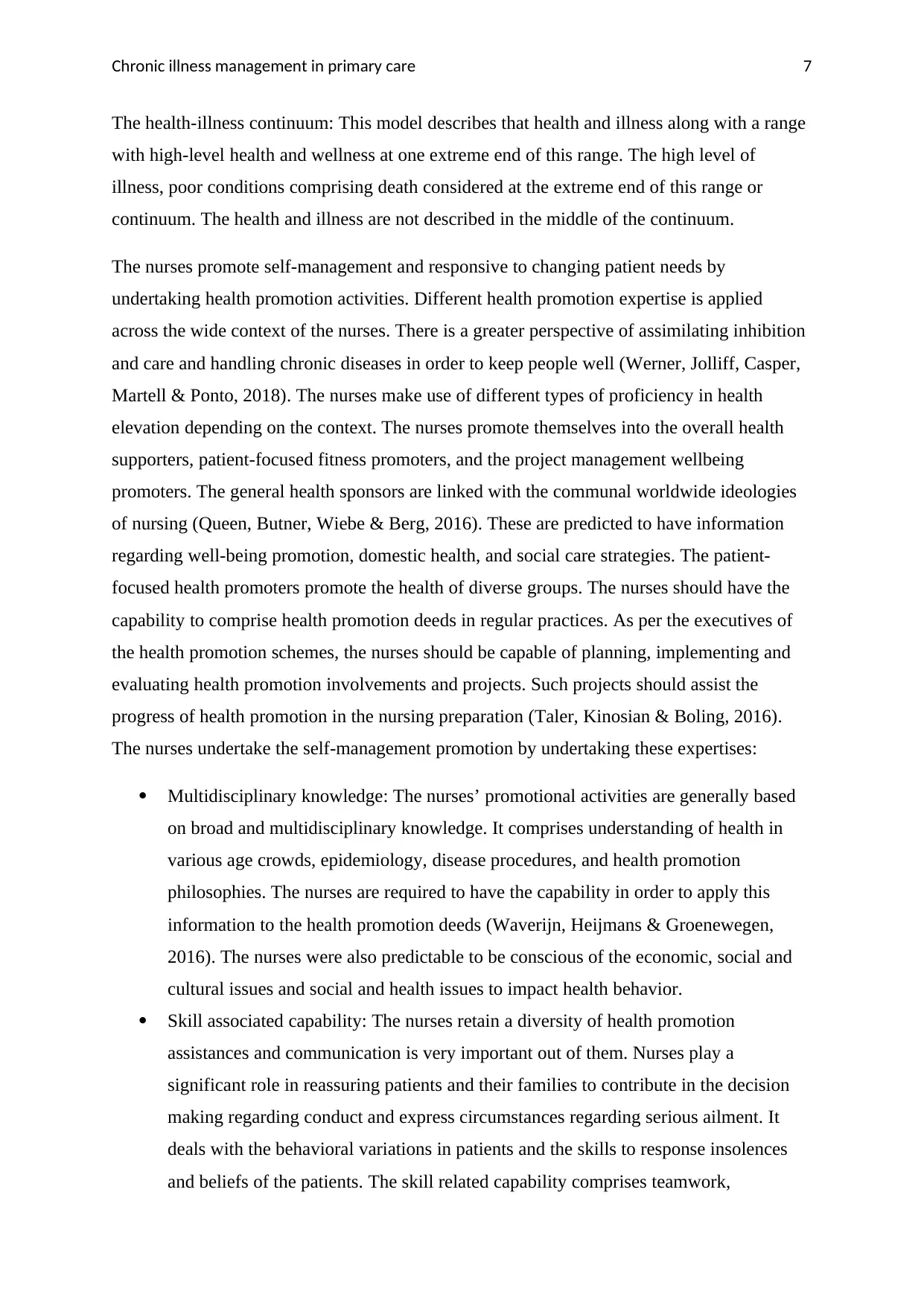
Chronic illness management in primary care 7
The health-illness continuum: This model describes that health and illness along with a range
with high-level health and wellness at one extreme end of this range. The high level of
illness, poor conditions comprising death considered at the extreme end of this range or
continuum. The health and illness are not described in the middle of the continuum.
The nurses promote self-management and responsive to changing patient needs by
undertaking health promotion activities. Different health promotion expertise is applied
across the wide context of the nurses. There is a greater perspective of assimilating inhibition
and care and handling chronic diseases in order to keep people well (Werner, Jolliff, Casper,
Martell & Ponto, 2018). The nurses make use of different types of proficiency in health
elevation depending on the context. The nurses promote themselves into the overall health
supporters, patient-focused fitness promoters, and the project management wellbeing
promoters. The general health sponsors are linked with the communal worldwide ideologies
of nursing (Queen, Butner, Wiebe & Berg, 2016). These are predicted to have information
regarding well-being promotion, domestic health, and social care strategies. The patient-
focused health promoters promote the health of diverse groups. The nurses should have the
capability to comprise health promotion deeds in regular practices. As per the executives of
the health promotion schemes, the nurses should be capable of planning, implementing and
evaluating health promotion involvements and projects. Such projects should assist the
progress of health promotion in the nursing preparation (Taler, Kinosian & Boling, 2016).
The nurses undertake the self-management promotion by undertaking these expertises:
Multidisciplinary knowledge: The nurses’ promotional activities are generally based
on broad and multidisciplinary knowledge. It comprises understanding of health in
various age crowds, epidemiology, disease procedures, and health promotion
philosophies. The nurses are required to have the capability in order to apply this
information to the health promotion deeds (Waverijn, Heijmans & Groenewegen,
2016). The nurses were also predictable to be conscious of the economic, social and
cultural issues and social and health issues to impact health behavior.
Skill associated capability: The nurses retain a diversity of health promotion
assistances and communication is very important out of them. Nurses play a
significant role in reassuring patients and their families to contribute in the decision
making regarding conduct and express circumstances regarding serious ailment. It
deals with the behavioral variations in patients and the skills to response insolences
and beliefs of the patients. The skill related capability comprises teamwork,
The health-illness continuum: This model describes that health and illness along with a range
with high-level health and wellness at one extreme end of this range. The high level of
illness, poor conditions comprising death considered at the extreme end of this range or
continuum. The health and illness are not described in the middle of the continuum.
The nurses promote self-management and responsive to changing patient needs by
undertaking health promotion activities. Different health promotion expertise is applied
across the wide context of the nurses. There is a greater perspective of assimilating inhibition
and care and handling chronic diseases in order to keep people well (Werner, Jolliff, Casper,
Martell & Ponto, 2018). The nurses make use of different types of proficiency in health
elevation depending on the context. The nurses promote themselves into the overall health
supporters, patient-focused fitness promoters, and the project management wellbeing
promoters. The general health sponsors are linked with the communal worldwide ideologies
of nursing (Queen, Butner, Wiebe & Berg, 2016). These are predicted to have information
regarding well-being promotion, domestic health, and social care strategies. The patient-
focused health promoters promote the health of diverse groups. The nurses should have the
capability to comprise health promotion deeds in regular practices. As per the executives of
the health promotion schemes, the nurses should be capable of planning, implementing and
evaluating health promotion involvements and projects. Such projects should assist the
progress of health promotion in the nursing preparation (Taler, Kinosian & Boling, 2016).
The nurses undertake the self-management promotion by undertaking these expertises:
Multidisciplinary knowledge: The nurses’ promotional activities are generally based
on broad and multidisciplinary knowledge. It comprises understanding of health in
various age crowds, epidemiology, disease procedures, and health promotion
philosophies. The nurses are required to have the capability in order to apply this
information to the health promotion deeds (Waverijn, Heijmans & Groenewegen,
2016). The nurses were also predictable to be conscious of the economic, social and
cultural issues and social and health issues to impact health behavior.
Skill associated capability: The nurses retain a diversity of health promotion
assistances and communication is very important out of them. Nurses play a
significant role in reassuring patients and their families to contribute in the decision
making regarding conduct and express circumstances regarding serious ailment. It
deals with the behavioral variations in patients and the skills to response insolences
and beliefs of the patients. The skill related capability comprises teamwork,
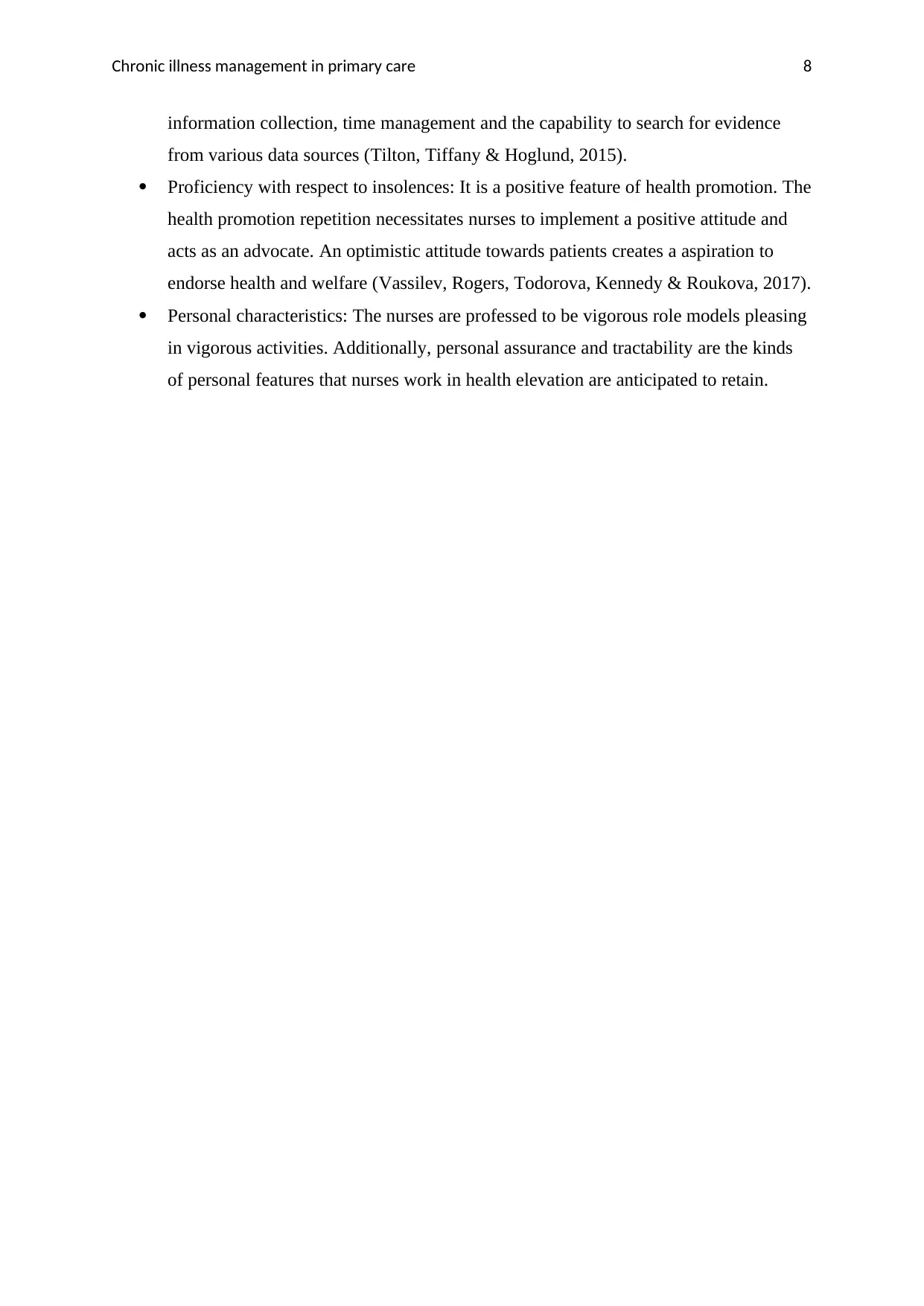
Chronic illness management in primary care 8
information collection, time management and the capability to search for evidence
from various data sources (Tilton, Tiffany & Hoglund, 2015).
Proficiency with respect to insolences: It is a positive feature of health promotion. The
health promotion repetition necessitates nurses to implement a positive attitude and
acts as an advocate. An optimistic attitude towards patients creates a aspiration to
endorse health and welfare (Vassilev, Rogers, Todorova, Kennedy & Roukova, 2017).
Personal characteristics: The nurses are professed to be vigorous role models pleasing
in vigorous activities. Additionally, personal assurance and tractability are the kinds
of personal features that nurses work in health elevation are anticipated to retain.
information collection, time management and the capability to search for evidence
from various data sources (Tilton, Tiffany & Hoglund, 2015).
Proficiency with respect to insolences: It is a positive feature of health promotion. The
health promotion repetition necessitates nurses to implement a positive attitude and
acts as an advocate. An optimistic attitude towards patients creates a aspiration to
endorse health and welfare (Vassilev, Rogers, Todorova, Kennedy & Roukova, 2017).
Personal characteristics: The nurses are professed to be vigorous role models pleasing
in vigorous activities. Additionally, personal assurance and tractability are the kinds
of personal features that nurses work in health elevation are anticipated to retain.
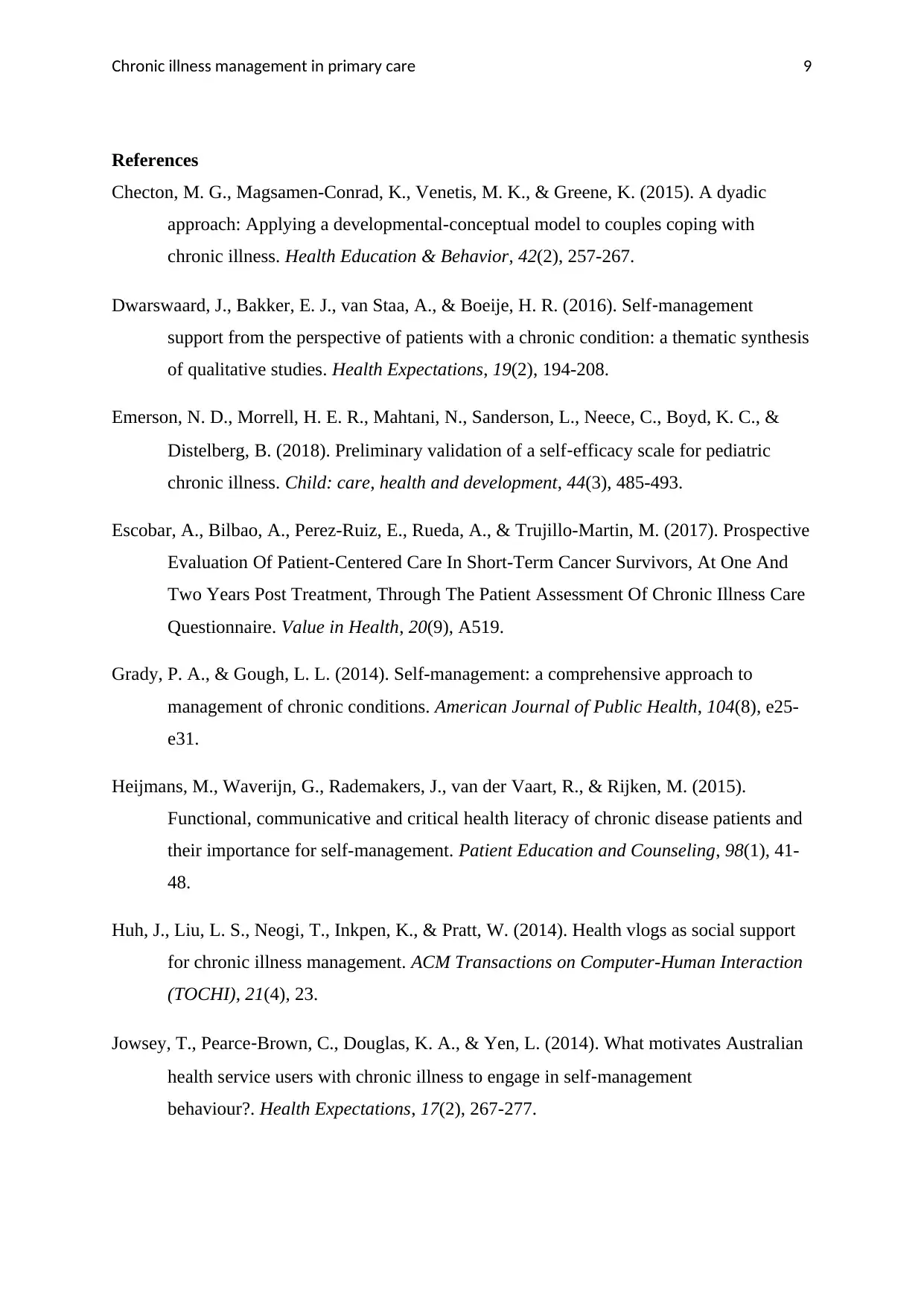
Chronic illness management in primary care 9
References
Checton, M. G., Magsamen-Conrad, K., Venetis, M. K., & Greene, K. (2015). A dyadic
approach: Applying a developmental-conceptual model to couples coping with
chronic illness. Health Education & Behavior, 42(2), 257-267.
Dwarswaard, J., Bakker, E. J., van Staa, A., & Boeije, H. R. (2016). Self‐management
support from the perspective of patients with a chronic condition: a thematic synthesis
of qualitative studies. Health Expectations, 19(2), 194-208.
Emerson, N. D., Morrell, H. E. R., Mahtani, N., Sanderson, L., Neece, C., Boyd, K. C., &
Distelberg, B. (2018). Preliminary validation of a self‐efficacy scale for pediatric
chronic illness. Child: care, health and development, 44(3), 485-493.
Escobar, A., Bilbao, A., Perez-Ruiz, E., Rueda, A., & Trujillo-Martin, M. (2017). Prospective
Evaluation Of Patient-Centered Care In Short-Term Cancer Survivors, At One And
Two Years Post Treatment, Through The Patient Assessment Of Chronic Illness Care
Questionnaire. Value in Health, 20(9), A519.
Grady, P. A., & Gough, L. L. (2014). Self-management: a comprehensive approach to
management of chronic conditions. American Journal of Public Health, 104(8), e25-
e31.
Heijmans, M., Waverijn, G., Rademakers, J., van der Vaart, R., & Rijken, M. (2015).
Functional, communicative and critical health literacy of chronic disease patients and
their importance for self-management. Patient Education and Counseling, 98(1), 41-
48.
Huh, J., Liu, L. S., Neogi, T., Inkpen, K., & Pratt, W. (2014). Health vlogs as social support
for chronic illness management. ACM Transactions on Computer-Human Interaction
(TOCHI), 21(4), 23.
Jowsey, T., Pearce‐Brown, C., Douglas, K. A., & Yen, L. (2014). What motivates Australian
health service users with chronic illness to engage in self‐management
behaviour?. Health Expectations, 17(2), 267-277.
References
Checton, M. G., Magsamen-Conrad, K., Venetis, M. K., & Greene, K. (2015). A dyadic
approach: Applying a developmental-conceptual model to couples coping with
chronic illness. Health Education & Behavior, 42(2), 257-267.
Dwarswaard, J., Bakker, E. J., van Staa, A., & Boeije, H. R. (2016). Self‐management
support from the perspective of patients with a chronic condition: a thematic synthesis
of qualitative studies. Health Expectations, 19(2), 194-208.
Emerson, N. D., Morrell, H. E. R., Mahtani, N., Sanderson, L., Neece, C., Boyd, K. C., &
Distelberg, B. (2018). Preliminary validation of a self‐efficacy scale for pediatric
chronic illness. Child: care, health and development, 44(3), 485-493.
Escobar, A., Bilbao, A., Perez-Ruiz, E., Rueda, A., & Trujillo-Martin, M. (2017). Prospective
Evaluation Of Patient-Centered Care In Short-Term Cancer Survivors, At One And
Two Years Post Treatment, Through The Patient Assessment Of Chronic Illness Care
Questionnaire. Value in Health, 20(9), A519.
Grady, P. A., & Gough, L. L. (2014). Self-management: a comprehensive approach to
management of chronic conditions. American Journal of Public Health, 104(8), e25-
e31.
Heijmans, M., Waverijn, G., Rademakers, J., van der Vaart, R., & Rijken, M. (2015).
Functional, communicative and critical health literacy of chronic disease patients and
their importance for self-management. Patient Education and Counseling, 98(1), 41-
48.
Huh, J., Liu, L. S., Neogi, T., Inkpen, K., & Pratt, W. (2014). Health vlogs as social support
for chronic illness management. ACM Transactions on Computer-Human Interaction
(TOCHI), 21(4), 23.
Jowsey, T., Pearce‐Brown, C., Douglas, K. A., & Yen, L. (2014). What motivates Australian
health service users with chronic illness to engage in self‐management
behaviour?. Health Expectations, 17(2), 267-277.
Secure Best Marks with AI Grader
Need help grading? Try our AI Grader for instant feedback on your assignments.
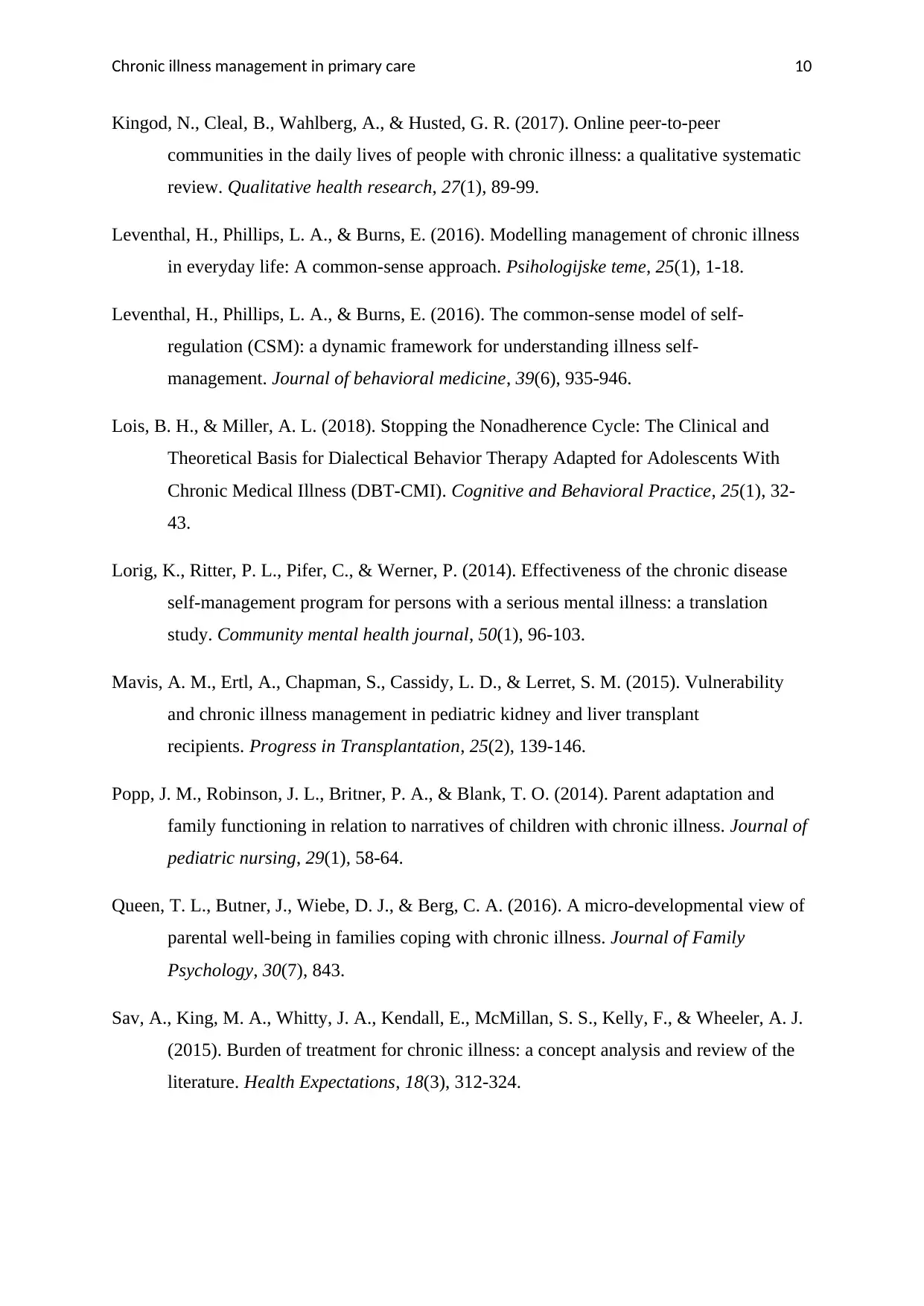
Chronic illness management in primary care 10
Kingod, N., Cleal, B., Wahlberg, A., & Husted, G. R. (2017). Online peer-to-peer
communities in the daily lives of people with chronic illness: a qualitative systematic
review. Qualitative health research, 27(1), 89-99.
Leventhal, H., Phillips, L. A., & Burns, E. (2016). Modelling management of chronic illness
in everyday life: A common-sense approach. Psihologijske teme, 25(1), 1-18.
Leventhal, H., Phillips, L. A., & Burns, E. (2016). The common-sense model of self-
regulation (CSM): a dynamic framework for understanding illness self-
management. Journal of behavioral medicine, 39(6), 935-946.
Lois, B. H., & Miller, A. L. (2018). Stopping the Nonadherence Cycle: The Clinical and
Theoretical Basis for Dialectical Behavior Therapy Adapted for Adolescents With
Chronic Medical Illness (DBT-CMI). Cognitive and Behavioral Practice, 25(1), 32-
43.
Lorig, K., Ritter, P. L., Pifer, C., & Werner, P. (2014). Effectiveness of the chronic disease
self-management program for persons with a serious mental illness: a translation
study. Community mental health journal, 50(1), 96-103.
Mavis, A. M., Ertl, A., Chapman, S., Cassidy, L. D., & Lerret, S. M. (2015). Vulnerability
and chronic illness management in pediatric kidney and liver transplant
recipients. Progress in Transplantation, 25(2), 139-146.
Popp, J. M., Robinson, J. L., Britner, P. A., & Blank, T. O. (2014). Parent adaptation and
family functioning in relation to narratives of children with chronic illness. Journal of
pediatric nursing, 29(1), 58-64.
Queen, T. L., Butner, J., Wiebe, D. J., & Berg, C. A. (2016). A micro-developmental view of
parental well-being in families coping with chronic illness. Journal of Family
Psychology, 30(7), 843.
Sav, A., King, M. A., Whitty, J. A., Kendall, E., McMillan, S. S., Kelly, F., & Wheeler, A. J.
(2015). Burden of treatment for chronic illness: a concept analysis and review of the
literature. Health Expectations, 18(3), 312-324.
Kingod, N., Cleal, B., Wahlberg, A., & Husted, G. R. (2017). Online peer-to-peer
communities in the daily lives of people with chronic illness: a qualitative systematic
review. Qualitative health research, 27(1), 89-99.
Leventhal, H., Phillips, L. A., & Burns, E. (2016). Modelling management of chronic illness
in everyday life: A common-sense approach. Psihologijske teme, 25(1), 1-18.
Leventhal, H., Phillips, L. A., & Burns, E. (2016). The common-sense model of self-
regulation (CSM): a dynamic framework for understanding illness self-
management. Journal of behavioral medicine, 39(6), 935-946.
Lois, B. H., & Miller, A. L. (2018). Stopping the Nonadherence Cycle: The Clinical and
Theoretical Basis for Dialectical Behavior Therapy Adapted for Adolescents With
Chronic Medical Illness (DBT-CMI). Cognitive and Behavioral Practice, 25(1), 32-
43.
Lorig, K., Ritter, P. L., Pifer, C., & Werner, P. (2014). Effectiveness of the chronic disease
self-management program for persons with a serious mental illness: a translation
study. Community mental health journal, 50(1), 96-103.
Mavis, A. M., Ertl, A., Chapman, S., Cassidy, L. D., & Lerret, S. M. (2015). Vulnerability
and chronic illness management in pediatric kidney and liver transplant
recipients. Progress in Transplantation, 25(2), 139-146.
Popp, J. M., Robinson, J. L., Britner, P. A., & Blank, T. O. (2014). Parent adaptation and
family functioning in relation to narratives of children with chronic illness. Journal of
pediatric nursing, 29(1), 58-64.
Queen, T. L., Butner, J., Wiebe, D. J., & Berg, C. A. (2016). A micro-developmental view of
parental well-being in families coping with chronic illness. Journal of Family
Psychology, 30(7), 843.
Sav, A., King, M. A., Whitty, J. A., Kendall, E., McMillan, S. S., Kelly, F., & Wheeler, A. J.
(2015). Burden of treatment for chronic illness: a concept analysis and review of the
literature. Health Expectations, 18(3), 312-324.
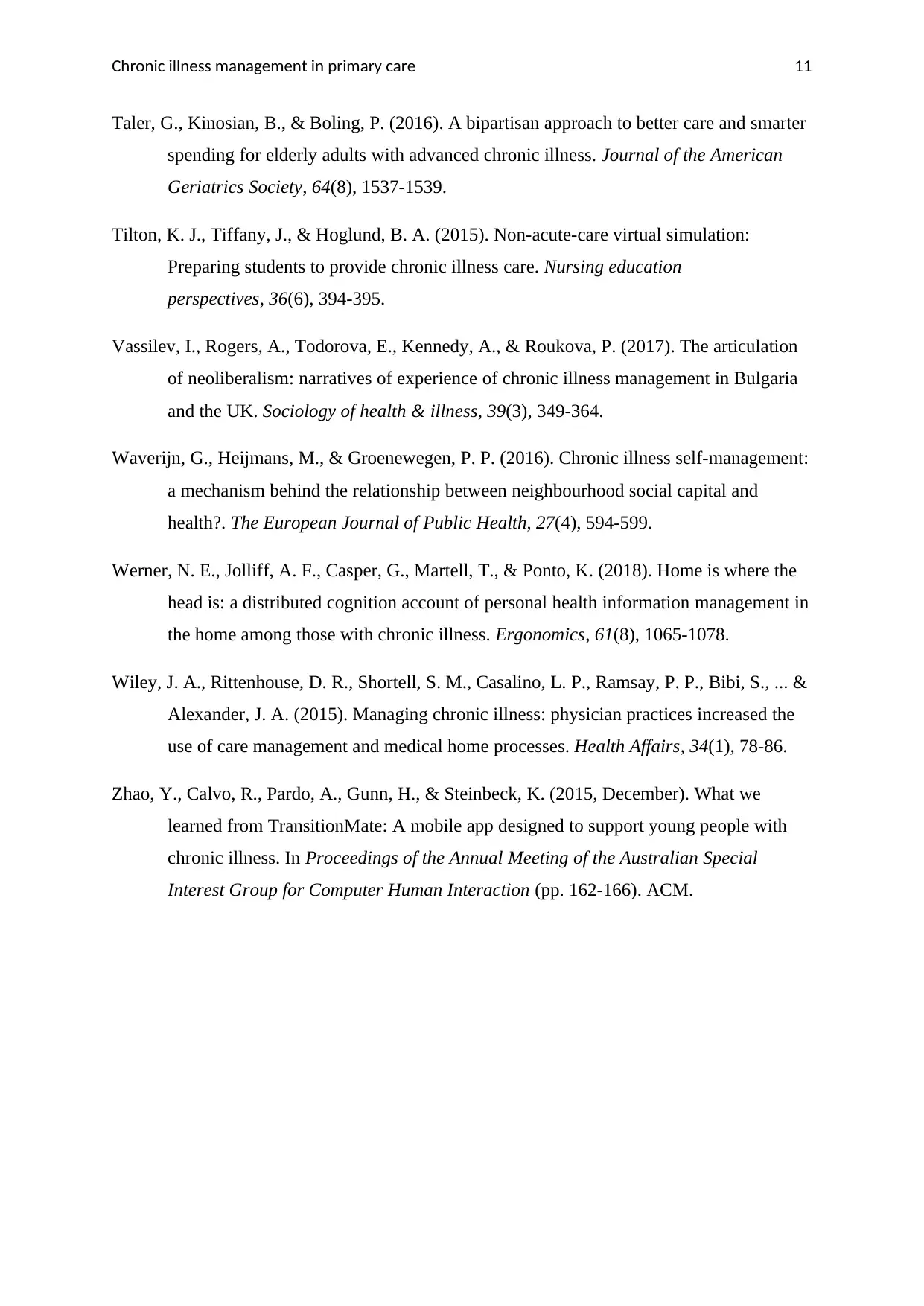
Chronic illness management in primary care 11
Taler, G., Kinosian, B., & Boling, P. (2016). A bipartisan approach to better care and smarter
spending for elderly adults with advanced chronic illness. Journal of the American
Geriatrics Society, 64(8), 1537-1539.
Tilton, K. J., Tiffany, J., & Hoglund, B. A. (2015). Non-acute-care virtual simulation:
Preparing students to provide chronic illness care. Nursing education
perspectives, 36(6), 394-395.
Vassilev, I., Rogers, A., Todorova, E., Kennedy, A., & Roukova, P. (2017). The articulation
of neoliberalism: narratives of experience of chronic illness management in Bulgaria
and the UK. Sociology of health & illness, 39(3), 349-364.
Waverijn, G., Heijmans, M., & Groenewegen, P. P. (2016). Chronic illness self-management:
a mechanism behind the relationship between neighbourhood social capital and
health?. The European Journal of Public Health, 27(4), 594-599.
Werner, N. E., Jolliff, A. F., Casper, G., Martell, T., & Ponto, K. (2018). Home is where the
head is: a distributed cognition account of personal health information management in
the home among those with chronic illness. Ergonomics, 61(8), 1065-1078.
Wiley, J. A., Rittenhouse, D. R., Shortell, S. M., Casalino, L. P., Ramsay, P. P., Bibi, S., ... &
Alexander, J. A. (2015). Managing chronic illness: physician practices increased the
use of care management and medical home processes. Health Affairs, 34(1), 78-86.
Zhao, Y., Calvo, R., Pardo, A., Gunn, H., & Steinbeck, K. (2015, December). What we
learned from TransitionMate: A mobile app designed to support young people with
chronic illness. In Proceedings of the Annual Meeting of the Australian Special
Interest Group for Computer Human Interaction (pp. 162-166). ACM.
Taler, G., Kinosian, B., & Boling, P. (2016). A bipartisan approach to better care and smarter
spending for elderly adults with advanced chronic illness. Journal of the American
Geriatrics Society, 64(8), 1537-1539.
Tilton, K. J., Tiffany, J., & Hoglund, B. A. (2015). Non-acute-care virtual simulation:
Preparing students to provide chronic illness care. Nursing education
perspectives, 36(6), 394-395.
Vassilev, I., Rogers, A., Todorova, E., Kennedy, A., & Roukova, P. (2017). The articulation
of neoliberalism: narratives of experience of chronic illness management in Bulgaria
and the UK. Sociology of health & illness, 39(3), 349-364.
Waverijn, G., Heijmans, M., & Groenewegen, P. P. (2016). Chronic illness self-management:
a mechanism behind the relationship between neighbourhood social capital and
health?. The European Journal of Public Health, 27(4), 594-599.
Werner, N. E., Jolliff, A. F., Casper, G., Martell, T., & Ponto, K. (2018). Home is where the
head is: a distributed cognition account of personal health information management in
the home among those with chronic illness. Ergonomics, 61(8), 1065-1078.
Wiley, J. A., Rittenhouse, D. R., Shortell, S. M., Casalino, L. P., Ramsay, P. P., Bibi, S., ... &
Alexander, J. A. (2015). Managing chronic illness: physician practices increased the
use of care management and medical home processes. Health Affairs, 34(1), 78-86.
Zhao, Y., Calvo, R., Pardo, A., Gunn, H., & Steinbeck, K. (2015, December). What we
learned from TransitionMate: A mobile app designed to support young people with
chronic illness. In Proceedings of the Annual Meeting of the Australian Special
Interest Group for Computer Human Interaction (pp. 162-166). ACM.
1 out of 12
Related Documents
Your All-in-One AI-Powered Toolkit for Academic Success.
+13062052269
info@desklib.com
Available 24*7 on WhatsApp / Email
![[object Object]](/_next/static/media/star-bottom.7253800d.svg)
Unlock your academic potential
© 2024 | Zucol Services PVT LTD | All rights reserved.





